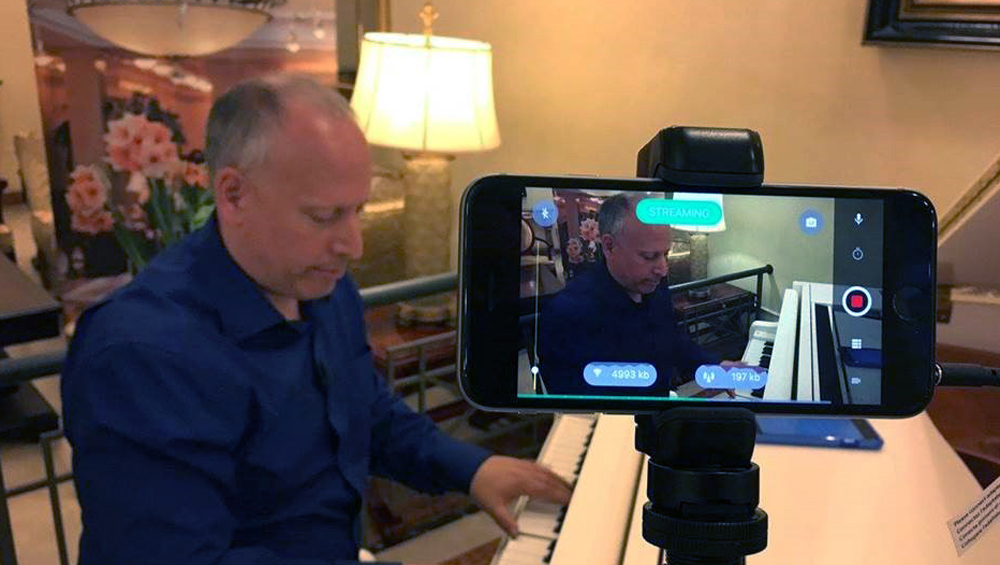
As Field Connectivity Soars, Focus Shifts To Metadata

With field connectivity “no longer the issue,” broadcasters are streamlining operations so journalists can focus on capturing content rather than the technical part of the job.
Sinclair Broadcast Group is running a pilot project at six stations to test a new workflow that automatically appends metadata to all video and can automatically send a proxy version of the content back to the station. That connection works two ways, as the station can also reach out to the camera to pull video as needed. Vendors are focusing on simplifying in-the-field workflows for journalists. And while blended cellular is increasingly mature, the 5G network and low earth orbit satellites are helping boost connectivity.
Sinclair’s Pilot Project
Ernie Ensign, Sinclair AVP, news technology and operations, says a field connectivity workflow pilot project aimed at acquiring content and getting that metadata-tagged data into the Avid platform quickly has been going on for almost a year.
“We are looking at ways to continually optimize that and make it easier for our photographers,” he says.
For the pilot project, Sinclair partnered up with Sony, Avid and a middleware firm, Marquis Broadcast, to deliver a proxy of video content directly from the camera to the newsroom’s Avid system as soon as it’s shot, complete with metadata already appended to it. When a newsroom writer creates a story in the Avid system, it pushes that name into Sony’s C3 Portal camera-to-cloud gateway service, making the name available as an option for the photographer to select for the content being shot.
“We want it to be an automated process, easy for the photographer,” Ensign says. “Their only job should be to connect to the hot spot and select the story, and then the camera does the rest.”
After the photographer selects what story the video supports, the Sony camera embeds metadata into the clips, he says, and as soon as the camera stops filming, the proxy video and metadata flows back to the Avid system, assisted by the middleware.
“We’ve seen fast turnaround on that,” he says, noting the resolution on the proxy version is high enough that it can be used on social media platforms. “In a pinch it can also be used on air.”

Sony’s C3 Portal camera-to-cloud gateway service is designed for newsgathering and file-based production, enabling fast and secure content delivery from the field.
One of the benefits of having metadata-tagged content immediately flow into the Avid system is that it provides better search tools after the fact, he says.
“The metadata is a big piece for us,” Ensign says.
An added benefit is that the metadata helps with rights management as content moves through the workflow, he says.
And having the camera automatically send content directly back to the newsroom gives the broadcaster more visibility into all content as it’s shot. Traditionally, he says, a photographer may transmit only a completed story back to the newsroom, rather than all the content.
“We do not want to leave content on the cutting room floor,” he says.
Ensign says Sinclair and its partners are still working to optimize the workflow. “Once we’re in a good position there, we can make a decision on rollout to the rest of the station group,” he says. “But there’s been great feedback so far.”
Martin Lindsay, business manager at Sony, says the automated transfer of proxy files to the newsroom simplifies the photographer’s job.
“The beauty of this is the operator can keep shooting. They don’t have to worry about pulling media out of their camera. It’s automated,” he says.
He says the cameras used in the proxy workflow Sinclair is testing simultaneously record both proxy and high bit rate files. And while the camera automatically sends files to the newsroom, the newsroom can reach out to the camera as well.
The newsroom can edit on the proxy version, then send a request to the camera to pull only the necessary high-res content “so that it becomes a high-res edit,” Lindsay says.
In situations with limited or costly bandwidth, it may make sense not to auto-push the proxy clips but have the newsroom reach out to access the content, he says.
“Even as they’re recording, we can playback, we can preview the material in the cameras,” he says.
Lindsay notes that the cameras are not intended to compete with backpack solutions. “It’s to complement that,” he says.
Developments Coming To NAB Show
During the NAB Show next month, Sony will show off its C3 Portal mobile application, which can allow a phone to transfer clips from a range of cameras, Lindsay adds.
Also at the show, Octopus will showcase the Octopus Journalist App, which makes it possible for journalists to remotely access all the wires, rundowns and planning items they would have in the studio. The app allows journalists to edit existing scripts and create new stories on their mobile phones. It also includes a prompter mode.
“While Octopus tools have rapidly adapted to home office workflows, changes in the broadcasting environment have motivated our developers to deliver additions to our products that can expand the range of activities that can be done,” Gabriel Janko, Octopus COO and sales director, said via email.
At NAB, Cobalt is announcing that SafeLink Gateway is now available as a cloud instance in addition to the openGear form factor. SafeLink transports audio and video content reliably over the internet with low latency. The SafeLink 8TS-VM, the virtual machine model, can be used for cloud redundancy switching, as well as ground-to-cloud and cloud-to-ground transmission using RIST. SafeLink can potentially transport content to 64 destinations, providing link protection to existing encoding/decoding infrastructures.
“To achieve remote production, especially in trucks at live events, a broadcaster will require an internet low latency protocol like RIST,” said Suzana Brady, Cobalt Digital SVP of worldwide sales and marketing, via email. “Cobalt’s 9992-ENC/DEC family of encoders/decoders support RIST, but in the case where the broadcaster doesn’t have RIST supported encoders/decoders, they can use Cobalt’s SafeLink Gateway with their legacy devices, which is now available as a cloud instance, to handle RIST transport.
Starlink And 5G
David Edwards, product manager of Vislink’s live production and 5G solutions, says Vislink’s Streamur Live streaming app enables journalists in the field to broadcast live on their mobile phones.
Following the earthquake in Turkey, “Some of the first journalists on the scene were broadcasting live on their mobile phone and were joined by full production teams,” he says.
Currently, he says, bonded cellular is engrained in the industry, making it likely there is reasonable connectivity in many places. However, he notes, there are places where cellular connection is not reliable, such as the Scottish Highlands were at the time of Queen Elizabeth II’s death, so low earth orbit satellite connectivity such as through Starlink may make sense.
“Forward-thinking news organizations brought Starlink and got connectivity from the highlands, days before the sat trucks showed up,” he says.

Dejero EnGo enables OUTtv to produce dynamic live content in the field.
Daniel Morin, technical account manager at Dejero, says the company set up its gateway appliance along with a Starlink terminal in Hyde Park for the queen’s funeral.
“There were loads of people there, and it allowed us to provide our customers a point of network entrance they could use to send content back to the station” because cellular connections were “challenged,” he says.
Last year, Dejero released its EnGo 265 and EnGo 3 units, which use cellular blending technology to provide low-latency throughput. The EnGo 265 is a LTE device, while the EnGo 3 supports 5G.
The EnGo 3x, which will be demonstrated at NAB with a fall launch expected, will be able to prioritize the traffic on the gateway, focusing on transmitting live feeds and conducting file transfers in the backgrounds, he says.
Arco Groenenberg, LiveU’s central region sales director, says the company is working a proof of concept with stations on an ingest solution that “closes the loop with metadata.”
It allows a crew in the field to pick up a story from the newsroom and sends video back to the station tagged with the relevant metadata, he says.
“The biggest advantage is it’s improving the workflow around metadata and saving time,” he says. “There are still some manual processes, so it eliminates a bottleneck in terms of marrying metadata and tagging from the field.”
Groenenberg says bonded cellular technology has become more reliable as it matured. The rollout of the 5G network has helped boost its reliability, he says.
TVU Networks CEO Paul Shen says customer demand for 5G capable connectivity equipment has grown. “It gives another layer of reliability and quality beyond what LTE can deliver.”
Something else Shen has noticed is an uptick in transmission of 4K content.
“Today with 5G, 4K and (high dynamic range) HDR is no longer an issue,” he says. “The transmission bandwidth is not that much more, and the picture quality is tremendous.”
In short, connectivity is “no longer the issue,” Shen says. “Whether they have a camera, a pack or phone, today the connectivity is all there.”
































Comments (0)